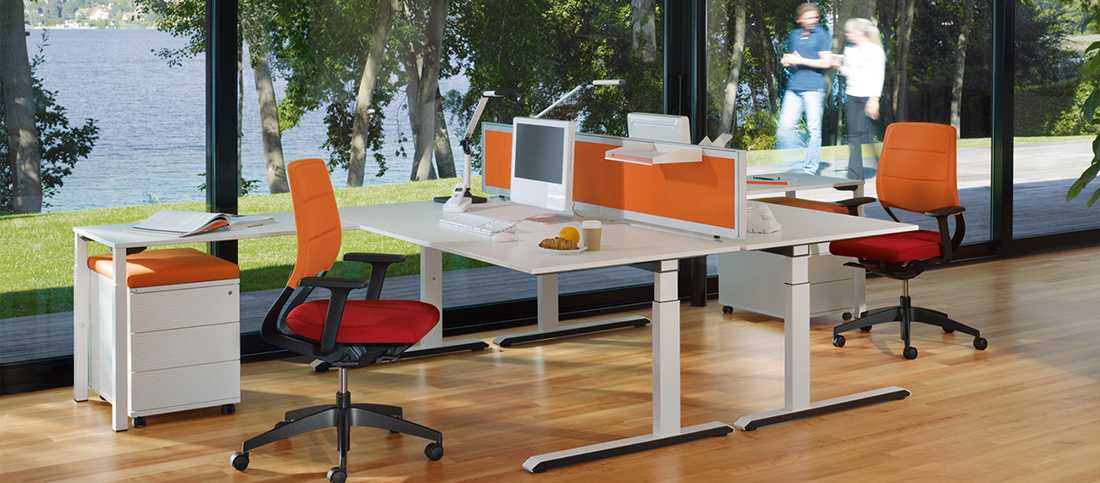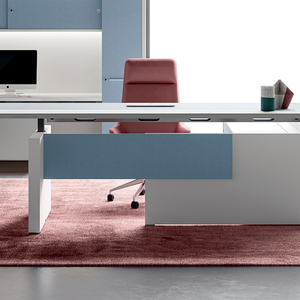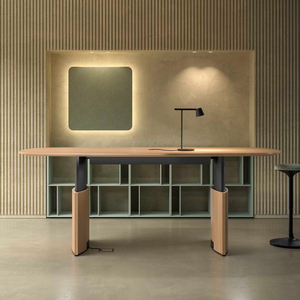- Home >
Height of an Italian workstation desk: what does the legislation say?

Index:
- What sizes and categories does the standard define for desks?
- What is Type A and when is it recommended?
- What is Type B and what limits does it have?
- What is Type C and for which uses is it suitable?
- What is Type D and which measurements does it require?
- How do I select the most suitable type for my project?
- How do I verify EN 527-1/2 compliance when purchasing or tendering?
- Electric height-adjustable or manual crank: which should I choose?
- What is the correct desk-to-chair relationship (UNI EN 1335)?
Any work environment can be a source of stress, especially when certain basic guidelines are not respected, especially regarding ergonomic and workstations size. The Italian office desks are not an exception, as the working activity is often constrained to them for many hours. There are precise regulations that define the height of the work surface, based of postural cues. Getting stuck for long continuous periods at a workstation that forces an incorrect posture, indeed, determines not only a decrease in profitability related to discomfort, but also the onset of even serious physical problems, ranging from back pain to consequences for vision.
What sizes and categories does the standard define for desks?
The features of a workstation desk are defined by the CEN (European Standardization Organization) with the law EN 527-I 2011. This standard is referred to by the Italian law for occupational safety D.LGS 81/08. According to the regulations, 4 types (A,B,C,D) have been defined for desks, based on the possibility of height adjustment by the user. The performance of the various types is variable: A allows complete freedom of height adjustment by the end user, B enables selectable height during assembly, C fixed-height desks, and D with adjustable and selectable height. Adjustable means the final height calibration, whereas selectable defines pre-set steps.
What is Type A and when is it recommended?
The A type allows a wide range of height adjustment and selection for both seated and standing operators. Standard A requires the workstation to be freely adjustable at any time to suit the operator's requirements. In terms of dimensions, this means seated operator with desk between 650 mm and 850 mm, standing operator between 950 mm and 1250 mm. This is an uncommon standard in Italy, where standing desks are not yet very successful, but it is particularly well established in Northern Europe. The position is adjusted by motorized controls that prevent the operator from physical efforts and the risk of damaging the workstation and what is on the work surface.
What is Type B and what limits does it have?
It is the static version of type A, from which it differs in that it cannot be modified post-installation. The heights are the same, divided into the two classes: sitting (650 mm-850 mm) and standing (950 mm-1250 mm). Type B desks are usually supplied already optimized for one of the two classes, and no modification can be made by the user after the final adjustment has been made by the installer.
What is Type C and for which uses is it suitable?
These are non-modifiable static desks with 740 mm +/- 20 mm sitting position and 1050 mm +/- 20 mm standing position. These desks do not allow any type of height adjustment operations. The standard for these desks is 600 mm to 800 mm depth. The variability in depth is related to the predominance of flat screens, which has reduced the need for monitor space. In case of a 600 mm desk, the standard requires not to approach it to the wall to ensure freedom of movement for the legs.
What is Type D and which measurements does it require?
Type D provides adjustable and selectable height with sitting between 680 mm and 760 mm, and standing between 1000 mm and 1180 mm. In order to ensure freedom of movement for the legs, Type D desks must have a depth of 850 mm.
How do I select the most suitable type for my project?
There is no standard for desk type selection, neither for sitting or standing position. Generally, the choice of both height and surface depends on the user needs. More comfortable workstations are preferrable for those who have to stand in front of the monitor for a long time. On the other hand, bigger solutions are ideal for managerial roles. In any case, guidance is also provided for the materials - that don’t have to be bright -, for their resistance under load, scratching and mechanical breakage, as well as the flexibility of the surface. The materials used to make the desks must also be non-toxic and fireproof. The selection of materials should follow both aesthetic and safety-related logics.
How do I verify EN 527-1/2 compliance when purchasing or tendering?
Always request: manufacturer’s declaration of conformity explicitly referencing EN 527-1 (dimensions) and EN 527-2 (safety); test reports for the specific model/code offered; technical drawing showing adjustment ranges and dimensions; user/maintenance manual. Check that the offered code matches the tested code and that measurements fall within the standard’s tolerances. For public buyers, add a CAM dossier if required by the specification.
Electric height-adjustable or manual crank: which should I choose?
The electric option is ideal for intensive use and multi-user spaces: quick adjustments, height memories, soft start/stop and often anti-collision; verify load rating (e.g., 60–120 kg), noise level and duty cycle. The manual crank is more economical and robust for stable workstations, but less suited to frequent height changes. In shared environments and wellbeing programmes, electric systems maximise sit–stand adoption.
What is the correct desk-to-chair relationship (UNI EN 1335)?
Coordinate the desk with a UNI EN 1335-compliant chair: target knee angle 90–100°, forearms parallel to the top, and 2–3 cm clearance between the seat front and the popliteal area. Adjust seat height first (typically 400–520 mm), then the desk height to keep shoulders relaxed and wrists neutral. This reduces postural compensations and makes the most of height adjustment.
We have selected the best height adjustable desks for you.
Height Adjustable Desks
- Buy from La Mercanti - Why?
- Discover what our Clients say
- Our contacts
Real reviews:
London - 5 ⭐Paris - 4.6 ⭐
Where can I find customer reviews for La Mercanti?
You can explore genuine reviews from our clients, including architects, companies and private professionals who have chosen La Mercanti for premium Italian office furniture solutions.





